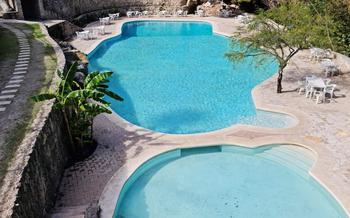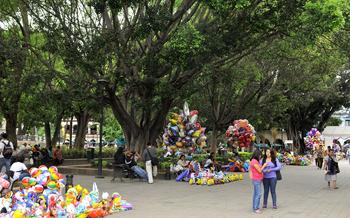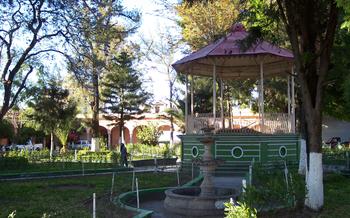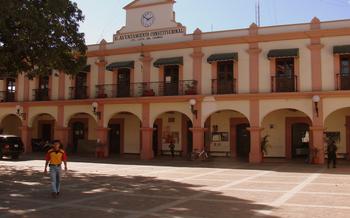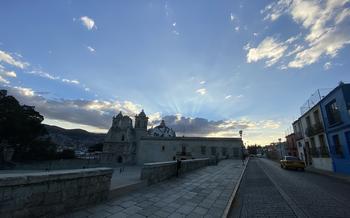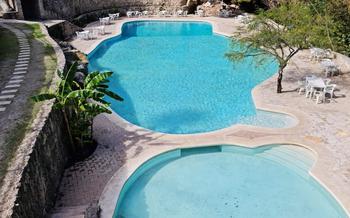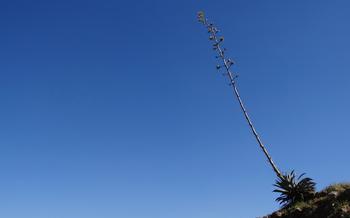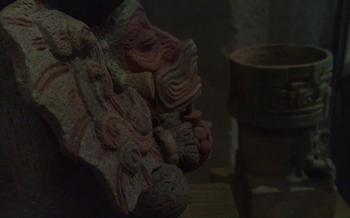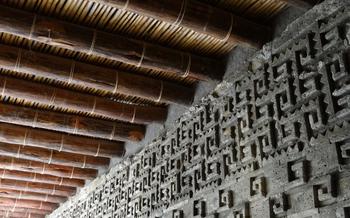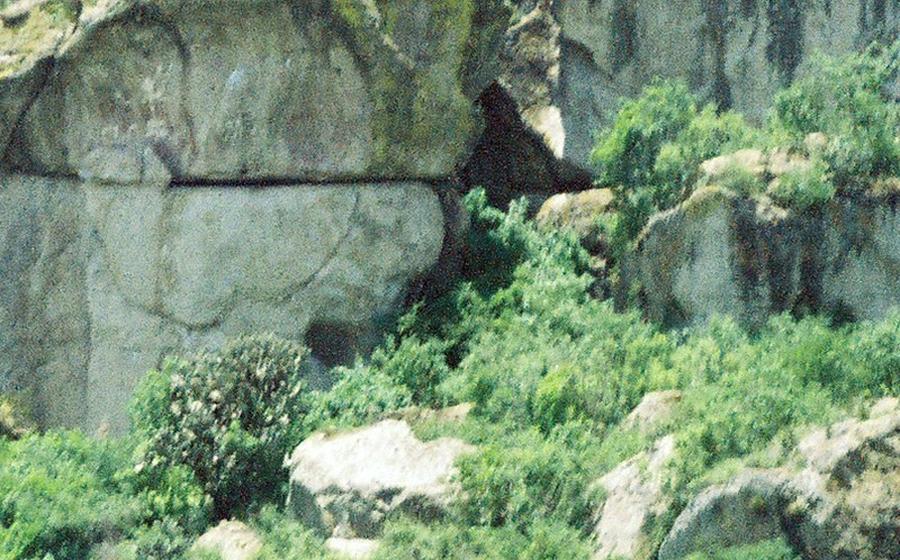
Guilá Naquitz Cave
- Historical Significance, Archaeological Findings, and Natural Beauty
- Location and Accessibility
- History and Cultural Significance
- Archaeological Discoveries
- The Cave's Natural Features
- The Zapotec Underworld
- Ethnobotanical Garden: A Realm of Native Plants
- Museo de las Culturas de Oaxaca (MACO)
- Photography and Videography
- Accommodations and Dining
- Ethical Considerations
- Insider Tip: Hidden Gems Nearby
Historical Significance, Archaeological Findings, and Natural Beauty
The Guilá Naquitz Cave holds immense historical significance as an ancient Zapotec settlement dating back to 1000 BC. Archaeological excavations within the cave have unearthed a treasure trove of artifacts, including ceramic pottery, figurines, and ceremonial objects, providing valuable insights into the daily life and rituals of the Zapotec civilization. Beyond its cultural significance, the cave boasts stunning natural beauty, adorned with impressive stalactites and stalagmites that have formed over millennia, creating a mesmerizing subterranean landscape.
Location and Accessibility
The Guilá Naquitz Cave is situated just 20 kilometers northeast of Oaxaca City, making it an easily accessible day trip from the city. You can conveniently take regular public buses from Oaxaca City to reach the cave, ensuring a hassle-free journey. For those who prefer a more comprehensive experience, guided tours are readily available, offering insightful commentary and an in-depth exploration of the cave's wonders.
History and Cultural Significance
The Guilá Naquitz Cave holds immense historical and cultural significance for the ancient Zapotec civilization. Its occupation dates back to 1000 BC, making it a testament to the rich cultural heritage of the region. The Zapotecs revered the cave as a sacred site, imbuing it with spiritual and religious importance. They utilized the cave as a place of worship, conducting ceremonies and rituals within its hallowed chambers. Furthermore, the cave served as a burial ground for the Zapotecs, their remains interred within the depths of the cave to accompany them into the afterlife. This profound connection to the cave highlights its central role in shaping the Zapotec culture and beliefs.
Archaeological Discoveries
The Guilá Naquitz Cave has yielded a wealth of archaeological treasures, providing valuable insights into the life and culture of the ancient Zapotecs. Excavations within the cave have uncovered a significant number of human remains, including skeletons and skulls, offering a glimpse into the physical characteristics and burial practices of this ancient civilization.
In addition to human remains, the cave has also revealed a diverse array of ceramic artifacts, ranging from pottery and figurines to ceremonial objects. These artifacts provide evidence of the Zapotecs' artistry, craftsmanship, and religious beliefs. The pottery, in particular, showcases the Zapotecs' mastery of ceramic techniques, with intricate designs and decorations adorning the vessels.
Furthermore, the discovery of stone tools within the cave sheds light on the Zapotecs' daily life and subsistence strategies. These tools, which include arrowheads, scrapers, and grinding stones, suggest that the Zapotecs were skilled hunters and gatherers, utilizing the resources of their surrounding environment.
The Cave's Natural Features
Guilá Naquitz Cave is renowned for its impressive natural features that have been shaped over millennia by the relentless forces of water and minerals. Stretching over a kilometer in length, the cave offers a captivating journey through a subterranean labyrinth adorned with majestic stalactites and stalagmites. These intricate formations, resembling frozen waterfalls and towering pillars, create an awe-inspiring spectacle that transports visitors to a realm of wonder and beauty.
As you venture deeper into the cave, you will encounter a subterranean river that flows gently through the chambers, adding an enchanting ambiance to the already mystical atmosphere. The river's presence not only enhances the cave's natural beauty but also serves as a testament to the dynamic geological processes that have shaped this underground sanctuary.
The Zapotec Underworld
The Guilá Naquitz Cave holds immense significance in Zapotec mythology, serving as the realm of the dead and the afterlife. Delve into the depths of the cave to discover cave paintings that depict deities and mythological scenes, offering a glimpse into the Zapotec beliefs and worldview. These paintings showcase the intricate symbolism and artistry of the ancient Zapotec civilization, providing valuable insights into their spiritual and cultural traditions. Exploring the cave is like embarking on a journey through the Zapotec underworld, unraveling their mythology and connecting with their profound reverence for the afterlife.
Ethnobotanical Garden: A Realm of Native Plants
Adjacent to the entrance of Guilá Naquitz Cave, visitors can immerse themselves in the Ethnobotanical Garden, a sanctuary of over 100 native plant species. This garden is a testament to the deep connection between the Zapotec people and the natural world.
The garden showcases a diverse array of plants, each holding cultural and medicinal significance. Visitors can admire the vibrant colors and unique forms of these botanical treasures. The Zapotec people have long revered these plants for their healing properties, using them in traditional medicine to treat various ailments.
Strolling through the Ethnobotanical Garden offers a glimpse into the rich ethnobotanical knowledge of the Zapotec culture. The garden serves as a living reminder of their profound understanding of the natural world and its profound role in their lives.
Museo de las Culturas de Oaxaca (MACO)
After exploring the Guilá Naquitz Cave, complement your understanding of the Zapotec civilization by visiting the Museo de las Culturas de Oaxaca (MACO) in Oaxaca City. This renowned museum houses an extensive collection of artifacts recovered from the cave, providing a deeper context to the cultural significance of the site. Admire the intricate pottery, ceremonial objects, and stone tools unearthed from Guilá Naquitz, gaining insights into the daily life, rituals, and beliefs of the ancient Zapotec people. Through interactive exhibits and informative displays, MACO offers a comprehensive journey into the rich history and cultural heritage of Oaxaca.
Photography and Videography
The awe-inspiring beauty of Guilá Naquitz Cave begs to be captured, but certain restrictions are in place to protect and preserve the delicate ecosystem within. While photography is generally permitted, flash photography and the use of tripods are strictly prohibited. These regulations aim to minimize disruption to the cave's natural environment and ensure the safety of visitors.
Respecting these guidelines is essential for preserving the cave's pristine beauty and allowing all visitors to enjoy its wonders. By adhering to these restrictions, you can contribute to the ongoing conservation efforts and ensure that future generations can continue to experience the magic of Guilá Naquitz Cave.
Remember, the cave's allure lies not only in its physical beauty but also in its cultural and historical significance. Take a moment to appreciate the profound connection between the Zapotec people and this sacred site, and let the cave's energy and atmosphere transport you back in time.
Accommodations and Dining
Finding accommodations and dining options near Guilá Naquitz Cave is a breeze. A variety of hotels and restaurants are situated in the immediate vicinity, offering a range of choices to suit every budget and preference. For those seeking a comfortable and convenient stay, several hotels are located within a short distance from the cave, providing easy access to the site.
When it comes to dining, visitors are in for a treat. The region surrounding Guilá Naquitz Cave is renowned for its culinary delights, with a plethora of restaurants serving up traditional Oaxacan cuisine. From mouthwatering moles and tlayudas to refreshing aguas frescas and mezcal cocktails, there's something to satisfy every palate. Whether you're seeking a casual dining experience or a fine-dining extravaganza, you'll find plenty of options to choose from.
Indulge in the flavors of Oaxaca by sampling the local specialties. Start your day with a hearty breakfast of huevos rancheros or chilaquiles, accompanied by freshly brewed Oaxacan coffee. For lunch, savor a traditional tlayuda, a crispy tortilla topped with beans, cheese, and your choice of meat or vegetables. And when dinnertime rolls around, treat yourself to a feast of mole negro, a rich and complex sauce served with chicken or pork.
Remember, sampling Oaxacan cuisine is not just about satisfying your taste buds; it's a cultural experience that allows you to connect with the region's rich heritage and traditions. So, embrace the opportunity to tantalize your palate and immerse yourself in the culinary delights of Oaxaca.
Ethical Considerations
As responsible travelers, it is essential to approach our visit to Guilá Naquitz with respect for the cultural and natural heritage of the site. Preserving and protecting this unique place for future generations is paramount. Here are some ethical considerations to keep in mind:
Avoid touching or damaging artifacts: The cave contains fragile artifacts and skeletal remains that are of great historical and cultural significance. Refrain from touching or disturbing these objects to ensure their preservation.
Practice sustainable tourism: Support local businesses and initiatives that promote sustainable tourism practices. Choose tour operators that prioritize responsible practices, such as using eco-friendly transportation and employing local guides.
Minimize waste: Bring reusable water bottles and snacks to reduce single-use plastic waste. Dispose of any trash properly in designated bins to keep the cave and its surroundings clean.
Respect local customs and traditions: Oaxaca is a region rich in cultural traditions. Be respectful of local customs and traditions by dressing appropriately and asking permission before taking photos of people or sacred sites.
By following these ethical guidelines, we can contribute to the preservation of Guilá Naquitz and support the local community while enjoying a meaningful and responsible travel experience.
Insider Tip: Hidden Gems Nearby
While exploring the Guilá Naquitz Cave, don't miss the opportunity to discover other hidden gems in the surrounding area. Just a short distance away, you can immerse yourself in the beauty of the Templo de Santo Domingo de Guzmán, a magnificent church renowned for its intricate Baroque architecture and opulent interior. For nature enthusiasts, the Sierra Norte National Park offers breathtaking landscapes, diverse flora and fauna, and the chance to witness the majestic flight of the Quetzal, a resplendent bird revered by the ancient Zapotecs.
Venturing off the beaten path, you'll find the Cascada del Amor, a secluded waterfall nestled amidst lush vegetation, inviting you to take a refreshing dip in its crystal-clear waters. History buffs will appreciate the Mitla Archaeological Zone, an ancient Zapotec city featuring well-preserved ruins and intricate mosaics. These hidden gems, easily accessible from Guilá Naquitz, provide a deeper dive into the rich cultural and natural heritage of Oaxaca, ensuring a truly unforgettable journey into the heart of this captivating region.

